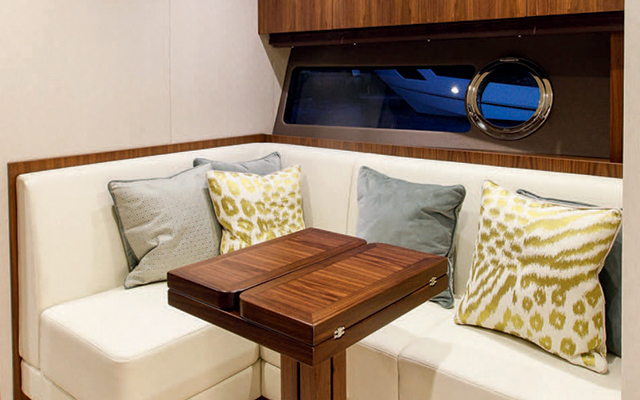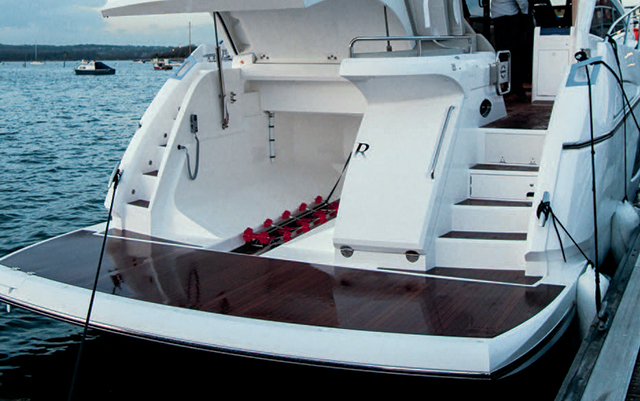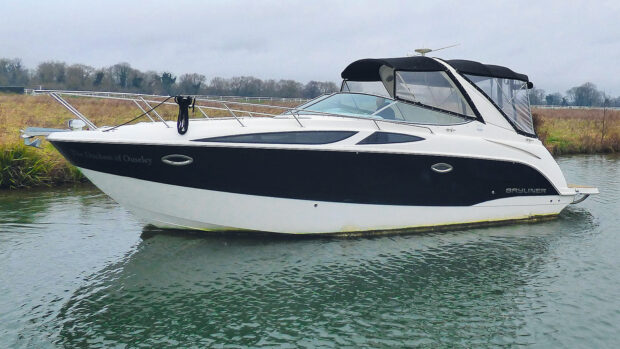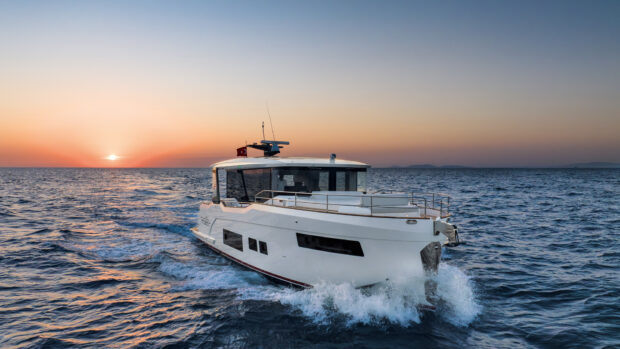The disappearing doors that transform the Predator from cosy cruiser to open suntrap might seem gimmicky but they’re underpinned by Sunseeker performance and quality.
At the launch of the Sunseeker Predator 57 at the London Boat Show just gone, aside from the papping of ‘that bird off the X Factor’ Nicole Scherzinger, a Queen cover band and excellent video showing various Thunder and Superhawks skipping off the crests, it was easy to forget that there was actually a brand new Predator being shown to the world for the first time.
You couldn’t really see it, for a start, such was the size of the crowd that flocked to Sunseeker’s stand but, despite not being a pop princess nor ex-girlfriend of Lewis Hamilton, the Sunseeker Predator 57 actually has plenty to shout about.
The standout feature is the way the boat transforms from fully enclosed, cosy winter wafter to a wide-open suntrap at the touch of a button. Well, two actually.

Doors down and roof open, the Sunseeker Predator 57 feels like a totally different boat to when it’s enclosed.
First you slide the starboard side of the two-piece cockpit door to port and, once both panes are together, push a button just inside the door and the whole lot disappears into a void below the deck, leaving a totally open aft end with just the seatbacks of the saloon and cockpit meeting to make a half-height partition.
The door mechanism needs a dash of refinement as it juddered its way down rather than slipping smoothly into the deck but this is hull number one, which has taken a good old boat show battering, with the doors going up and down more in a week than hull number two’s will in a decade.
Next, head to the dash, press button number two and the vast GRP roof recedes over the fixed aft section in around 30 seconds to create one of the largest roof apertures I have seen on any boat.

The starboard door slides across then both sections descend between the seatbacks. Cockpit wet-bar is essential in this galley-down layout.
It’s quite staggering how different the boat looks and feels with the doors down and roof peeled back.
And it’s this versatility that explains why Sunseeker has sold nearly 30 of these boats already.
In a warm climate you can keep the saloon beautifully air-conditioned in the day then open everything up for evening cruises when the temperature has dipped, and in chillier climes the saloon can be heated into a cosy cocoon, perfect for winter adventures.

With nothing to separate them, the Sunseeker Predator 57’s cockpit and saloon merge into one vast living space.
It’s easy to see why a good handful of these 57 orders are heading up to Scandinavia.
You really do get the best of both worlds; a spacious cockpit which manages to include a sunpad (over a tender garage large enough for a Williams 325), a big wrap of seating around a teak-topped table, and a wet-bar with griddle, fridge and icemaker, as well as a saloon with comfortable dinette seating around another table with a flatscreen TV secreted in the sideboard opposite.
You could make the saloon and cockpit blend together even more cohesively if you were to remove the carpet from the saloon.
Life on board the Sunseeker Predator 57
No area feels pinched or compromised apart from maybe the small lower dinette which could only really serve three for breakfast, but then why would you use that when you have a much more spacious seating area, not to mention better views, a few steps away?
You could lose the lower dinette altogether, if you think it’s going to be redundant, and replace it with an ensuite for your pals in the third cabin that also acts as a spacious day heads.
Personally, I think the lower dinette is worth keeping, especially if you are going to be cruising with just two of you as, sited opposite the galley, one person can sit and read the paper while the other poaches the morning eggs.

The galley opposite, though not enormous and lacking a full-size fridge/freezer, is helped out enormously by the headroom and light allowed by its location beneath the windscreen.
There is also an opening port to provide more light and quick ventilation during cooking plus bags of countertop, which is always handy.
There is a good variety of storage and all cupboards are held in place with robust catches to stop pots and pans escaping.

VIP gets an island berth with no steps either side, so getting in and out is easy.
Your crockery will be perfectly safe thanks to everything – even the salt and pepper shakers – getting their own bespoke fiddles within the eye-level cupboards.
It’s been a while since my last Sunseeker test and it was good to see that beneath the rakish lines, funky glazing and irrepressible brand image, the Poole yard really knows how to put boats together well.
The joinery is exceptional, even in the places you can’t see, and there is an air of quality that extends to such touches as the way the doors close with a satisfying clunk, the cupboards clack into place and how solid the flooring feels under foot.

A small breakfast dinette is a much better use of space than the usual chaise longue.
The master cabin is a real jewel, well within the realm of being a place where you spend time instead of just slumbering, changing or, well, you know… It has masses of headroom, is bursting with light thanks to the hull windows and the small breakfast dinette to starboard is infinitely more useful than a stylish yet rarely used chaise longue.
Why wouldn’t you make a coffee, grab the iPad and sit at your private breakfast table with a view out over the waterline?
The other two cabins are finished to the same excellent standard but, with the lower dinette in situ, they share the VIP’s ensuite heads.
On the throttles
Okay, that’s enough about what the boat’s like when it’s not moving, how about when you pin the throttles to the dash?
Well, pretty brisk for something that weighs 27.5 tonnes and probably a bit more, thanks to this being the first hull and therefore heavily laden for testing purposes.
We had the largest Volvo Penta D13 900hp engines on test in a shaftdrive configuration, though you can have them with IPS pods if you prefer.
The 800hp versions of these D13s are also available but the larger engines seem a great match for the hull.

The Sunseeker Predator 57’s best angle, in my opinion, packed with visual drama. It looks sleek, rakish and sporty, just as a Sunseeker should.
There is also a version of the Sunseeker Predator 57 available with Arneson surface drives and 2,400 of MAN’s finest horsepower.
So, if you like the idea of 45-knot performance, a monster rooster tail and the feel of a diesel pump in your hand then you know which one to go for.
Despite the promise of some punchy wind readings in Poole they never materialised on test day so the Sunseeker Predator 57 had a pretty easy ride, save for when we went charging through the wake of our Manhattan 55 photo boat.
The hull felt confident, solid and slam free, which is all the more impressive when you consider how far forward the helmsman sits and the echo chamber created by the open-plan interior on sportscruisers of this ilk.

The tender garage is large enough to hold a Williams 325 and a hydraulic bathing platform is standard fit.
The dash was letting out a few too many squeaks for my liking but Sunseeker puts this down to the engineers needing regular access to the back of the console on the first boat, so this one wasn’t bedded down with sealant and bolted in place like it will be on later boats.
Sound readings were very impressive, especially at the helm where even at full chat the sound meter was registering only 76 dB(A) and, supposedly, the IPS version is even quieter.
What I doubt, though, is that the IPS version is any more fun to drive than the shaft version because the turn in, steering, quick-wittedness and downright fun of this set-up will be very hard to beat.
In my experience of IPS, although the initial turn in is quick, the boat then tends to flatten off and take quite a while to make the turn.

There are quality touches all over the Sunseeker Predator 57, from the chunky mooring gear to the stainless transom gate and flawless mouldings.
The shaftdrive boat’s turning circle was impressively tight, even at high speed, plus you get the other benefit of a shaftdrive boat, which is that sensation of being hunkered down in the water.
This is put to the ultimate test during our close-quarter boat-to-boat photography.
With a Manhattan 55 thundering along at 28 knots 10ft away from us, the Predator tracked along perfectly straight with very little input from the wheel.
Admittedly, your average owner is unlikely to find themselves in this situation but this translates into a reassuring grasp on the water and the agile handling will come into its own when you’re surrounded by pots, like we were off Old Harry Rocks, or when you’re barrelling home in a following sea.
When you stand at the helm with the roof closed it feels like the geometry of the roof is all wrong and blocks the view for all but the very shortest of skippers.

Flush-fitted helm switchgear looks the part.
However, sit down and it all drops into place and you recline with the wheel and throttles within easy reach and a great view out over the bow, totally unimpeded by the heavily sloped roof.
She climbs on to the plane over a bit of a hump but if you crane your neck for a few seconds she levels off into an easy canter.
The trim tabs are controlled by four separate, flush-fitted buttons, which match the rest of the controls on what is a great looking dashboard.
Sunseeker says that the four buttons represent the four corners of the boat, so to speak, so if you want port bow down for example, you press the top left button.
It makes sense on paper but personally I found it rather clunky and would have preferred two rocker switches with an indicator to show where the tabs are in their travel.

Bolster and foot plate mean you can see over the top of the windscreen.
Of course, if this is your boat then I’m sure the system will become second nature but I struggled to get to grips with it during my few hours on board.
The same goes for the wipers, which have five, yes five, buttons to control and sync the various cycles of wipe.
Sunseeker says customer and dealer feedback has been brilliant but it’s something else I struggled to fathom.
This accusation can be levelled at pretty much any manufacturer out there, not just Sunseeker.

Flush-fitted helm switchgear looks the part.
When is someone going to stick a wiper stalk on the steering wheel hub, which you pull towards you to wash the windscreen and click upwards in increments to increase wiper speed?
You could even have a twisting section on the end to control the navigation and anchor lights.
I know the technology exists because every car built since 1970 has one.
A closer look at the Sunseeker Predator 57 with Jack Haines
Ventilation
Elongated hull window allows even more natural light into the galley and the opening port gives some natural ventilation on top of the extractor fan.
Sliding doors

Sliding doors.
We have seen these solutions before but Sunseeker’s is simple and very effective. Shown slid together here, the doors then glide into a void in the deck.
Sunroof
One of the largest sunroofs I’ve seen on any boat and the glazing means that natural light can still get in when it’s closed. Transforms the boat when open.
Engineroom

Plentiful artificial light and a fresh water hose are desirable touches.
The tender garage moulding impedes access to the port engine but the quality of the installation can’t be faulted.
Plentiful artificial light and a fresh water hose are desirable touches.
Sunseeker Predator 57 verdict
Wiper rant aside, the Sunseeker Predator 57 is a boat that nails the basics but also has some star quality that gives you serious food for thought when comparing it to its rivals.
I can’t overstate the way this boat transforms from closed to open and we were doing it in the bitter chill of a February morning in Poole.
Of equal delight is the subtle quality of the boat, underpinning the party tricks and giving you confidence that the Predator is a boat to be used.
And it is built to be used; as enjoyable as those clever opening doors and roof are in the summer, they are just as effective on a bitter winter morning when you can leave them closed, start the engines and head off for a pub visit with the heating on and no need to wrap yourself up like you’re off to the North Pole.
And let’s not overlook the options you have when it comes to propulsion and drive choices.
Three engine variants and three very different drive set-ups mean you can tailor the Sunseeker Predator 57’s handling and performance to your exact needs. I love that there is a 45-knot version available, it’s just so… Sunseeker.
It’s this combination of style, quality and glamour balanced by strong seakeeping, punchy performance and genuine usability that makes the Sunseeker Predator 57 such a heady concoction and a star in its own right.
First published in the April 2015 issue of MBY.
Details
Price from: £1.08m (Twin D13 900)
Price as tested: £1.24m (Twin D13 900)
Med package (Options on test boat): £99,077
Navigation upgrade (Options on test boat): £21,481
AV upgrade (Options on test boat): £11,416
Length overall: 60ft 1in (18.3m)
Beam: 15ft 5in (4.7m)
Fuel capacity: 484 imp gal (2,200 litres)
Water capacity: 132 imp gal (600 litres)
Draught: 4ft 3in (1.3m)
Displacement: 27.5 tonnes (half load)
RCD category: B for 12 people
Designers: Sunseeker










